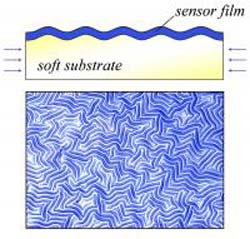Soft materials buckle up for measurement

NIST researchers developed a new high-speed method for measuring the stiffness of soft-polymer materials like those used in contact lenses. The test material is covered with a sensor film, and the combination is compressed until it buckles. The resulting pattern of ridges is the key to determining stiffness, an important material property. Credit: NIST
The new method uses “sensor films” with known properties to report the stiffness (or “modulus”) of the soft substrates to which they are attached. Compressing the sample causes the sensor film to buckle, resulting in patterns of repeating ridge-like features, akin to corrugated cardboard. The ridge spacing is related to the modulus ratio between the film and the soft substrate. Since the mechanical properties of the sensor film was known, the researchers could calculate the stiffness of the soft material underneath.
In the journal article, the team focuses on results achieved with model soft specimens, such as silicone polymer, and more challenging “hydrogel” specimens (networks of polymers swollen with water). In each case, the researchers tested “gradient” specimens that changed in their mechanical properties across the lengths of a sample. With the sensor film, they could track and measure changes in stiffness in the underlying materials.
This capability makes it possible to “map” spatial variations in rigidity in complex materials and devices. Accordingly, the new method may be a powerful tool to test for flaws or weak regions in soft materials products, the researchers suggest.
Another key aspect of the technique is its speed. The NIST team is working with industrial partners to harness this method as a high-throughput measurement tool for rapidly testing large numbers of soft polymer products. For more information on this aspect of the research, see the NIST Combinatorial Methods Center Web site (www.nist.gov/combi).
Media Contact
More Information:
http://www.nist.gov/combiAll latest news from the category: Materials Sciences
Materials management deals with the research, development, manufacturing and processing of raw and industrial materials. Key aspects here are biological and medical issues, which play an increasingly important role in this field.
innovations-report offers in-depth articles related to the development and application of materials and the structure and properties of new materials.
Newest articles

Superradiant atoms could push the boundaries of how precisely time can be measured
Superradiant atoms can help us measure time more precisely than ever. In a new study, researchers from the University of Copenhagen present a new method for measuring the time interval,…

Ion thermoelectric conversion devices for near room temperature
The electrode sheet of the thermoelectric device consists of ionic hydrogel, which is sandwiched between the electrodes to form, and the Prussian blue on the electrode undergoes a redox reaction…

Zap Energy achieves 37-million-degree temperatures in a compact device
New publication reports record electron temperatures for a small-scale, sheared-flow-stabilized Z-pinch fusion device. In the nine decades since humans first produced fusion reactions, only a few fusion technologies have demonstrated…





















